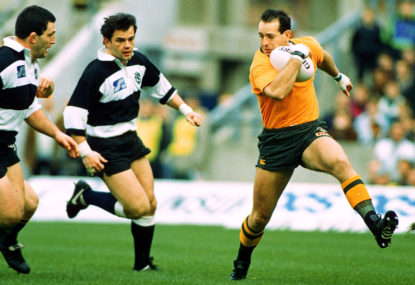Karl Stefanovic said it all on the Today Show recently as he watched the Wallaby forwards training during their Spring Tour of Great Britain: “Look at those big units.”
Yes, the physicality of rugby players has dramatically changed over the past 10 years. That – sadly in my view – is a reflection of the law changes that came into being in the late 1990s that has limited the running game, which has only been mastered by New Zealand’s provincial and national teams.
For sure there has been some cracker Test matches when muscle and mind have combined to create pulsating action like the recent Bledisloe Cup match in Brisbane.
It was great to see the Wallabies at last matching the All Blacks in ball speed and the physical confrontations as well as finally throwing the ball into the lineout accurately.
But in general two things have changed rugby as a game and as a product.
First halfbacks, normally the smallest guys on the field, now have to be around 180 centimetres or six feet in the old measurement. Gone are the days of a small whippy halfback running the blind.
At five-eighth players have to absorb huge backrower traffic and take them head-on. One has to ask would a skinny 18-year-old Mark Ella have pursued rugby now, and the unfortunate reality today is that the traditional game breakers (No.10) spend more time bringing down huge forwards than cutting the opposition up (Beauden Barrett excepted, but he hides behind a big mobile pack).

(AAP Image/SNPA, Dianne Manson)
Second, when you talk to former representative rugby players, those who played prior to 1995, they all ask the same question: where has all the space gone to attack and where have all those free running backline movements gone? When was the last time you saw a classic backline attack with the fullback chiming in to make the extra man, split the defence and take the ball 50 metres upfield?
Except for New Zealand teams who have the confidence to stand very deep in attack, rugby tries are now being scored mostly by relentless forward phases where each ball runner actually only takes a few steps before being cut down or an overlap created 10 metres out.
What rugby administrators and referees do not understand is that rugby, like every other sport, movie or live act, is an entertainment business first and foremost, and in this modern world you either put on a good show or go home.
Simply rugby has become a big man’s game – and a big woman’s game if the recent World Cup in Ireland is any guide. There New Zealand used their monstrous props to seal victory. They had a wonderful running fullback but she got few opportunities.
With the Wallabies on their northern hemisphere Spring Tour will we endure more 9-6 scorelines that their rugby fans love, with the game slowed down to a series of mauls and crash ball running.
Still there is one jewel in the crown for rugby as so rightly pointed out by my colleague David Lord and that is the game does not stop when someone is tackled, unlike in the greatest game of all. However my argument is this – rugby does not take advantage of this advantage; ie where the ball never dies.
Unfortunately it is the laws and referees’ fault that stops the running game from putting on its best show and instead has created a game dominated by huge bodies that would not know the first thing about David Campese’s acceleration or step.
And it is here we get the full blast of what rugby fans crave. In producing Campo’s career video, ‘Campese: Rugby’s My Life’, I sourced a cutaway from a Bledisloe Cup TV match coverage that has never before or since been seen at any sporting ground and that was a 10 metre long cloth sign held up by fans that said: “Campese Walks on Water.”
No other footy or cricket champion has had such a sign at a footy ground and it reflects what rugby fans crave for and that is athletically gifted players running the ball with forwards reduced to securing the ball and staying out of the way.

(Photo by Getty Images)
So let us throw in some law change suggestions that would help swing the pendulum back in the running game’s favour. They include:
1. Change the whole philosophy of the game from defensive (which it is now) to attacking and use technology to achieve it.
2. Create a 10-metre gap between the two teams after phase 1, so both teams are five or more metres back from the breakdown and no this is not Rugby League because in Rugby the game does not stop at the breakdown. What it does achieve is provide the attacking team with space to create and employ moves which is what fans crave a la David Campese.
3. Reduce the game to a ten-law game and use technology to achieve this by placing a GPS chip inside the ball and have 10-metre electronic lines light up and down the field which allows players and officials to know when they are onside or offside.
4. Take away kicking the ball out on the full inside the 22-metre zone, eliminate marks, and introduce further incentives for teams to go for a try rather than kick penalty goals such as make the conversion worth three points, the same as a penalty.
5. Go recruit the best athletically gifted kids from far and wide and show them how the game has changed where they influence the game more than hulking forwards who now have to be more lithe to keep up.
6. Establish a referees school where they are taught the 10 laws but brainwashed with the attitude that Rugby is not about them but rather the fans and continuity is the mantra. By reducing the laws to just 10 it means they also will have less to adjudicate on.
7. And, safely change the scrum laws and protocol so we do not have to sit around for two minutes watching a scrum come together. This is up there as one of the biggest blights on the game and while I acknowledge scrummaging is sacred to rugby, as an entertainment factor it is a fizzer.
With rugby being played in over 140 countries it is in a wonderful position to capitalise on its massive footprint by making the product more entertaining to fans and most importantly kids and families.
Eliminate 130 laws, brainwash the referees into thinking like a live sports director and bring back the running game I say. My final wish is this: Rugby is a giant around the world and on the field and it could become even greater if only some of the giants were replaced by David Campese.































































































